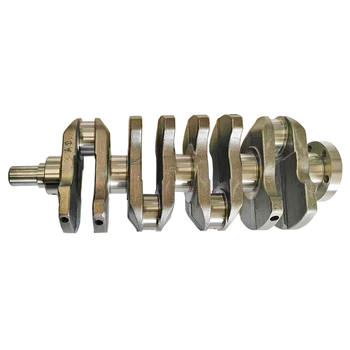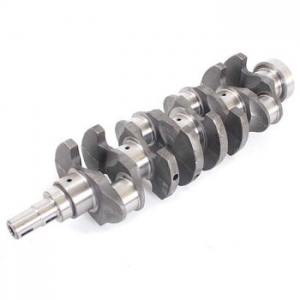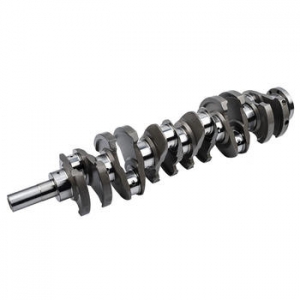In the heart of every internal combustion engine lies a component arguably as critical as the pistons themselves: the crankshaft. It's the central rotating element that converts the linear motion of the pistons into rotational motion, ultimately driving the wheels of your vehicle. For standard, everyday engines, a conventionally manufactured crankshaft is perfectly adequate. But step into the world of high-performance engines, where power output is pushed to extremes and RPMs soar, and suddenly the limitations of a stock crankshaft become glaringly apparent. This is where the specialized realm of the performance crankshaft comes into play. It’s not just an ordinary part; it’s a meticulously engineered component designed to withstand immense forces, higher temperatures, and rotational speeds far beyond what a standard unit can handle. Understanding the fundamental differences and the crucial role a performance crankshaft plays is the first step in appreciating its value in any serious engine build. Have you ever wondered what makes high-horsepower engines reliable under punishing conditions? Often, the answer starts with the strength and precision of its rotating assembly, beginning with the crankshaft.
To be honest, the demands placed on a crankshaft in a high-performance application are staggering. Think about the explosive force from combustion pushing down on the piston, transferred through the connecting rod to the crank pin. This happens thousands of times per minute. A standard crankshaft, typically cast iron or nodular iron, simply isn't designed to endure the peak cylinder pressures, the rapid acceleration and deceleration, or the prolonged high-RPM operation that define a performance engine. These forces can lead to deflection, bending, and ultimately, catastrophic failure. A performance crankshaft, on the other hand, is typically made from superior materials, undergoes more rigorous manufacturing processes, and features design enhancements specifically aimed at increasing strength, durability, and torsional rigidity. It’s built to laugh in the face of the stress that would snap a stock crank like a twig. This fundamental difference in resilience is what allows builders to chase higher power figures and push engine limits with confidence, knowing the core rotating component can handle the abuse.
Forged Crankshaft Benefits and Manufacturing Precision
The material and how it's shaped are paramount in the creation of a robust performance crankshaft. While many stock crankshafts are produced via casting, where molten metal is poured into a mold, performance units almost exclusively rely on forging. Forging is a process where metal is heated and then shaped under extreme pressure, aligning the metal's grain structure along the shape of the part. This results in a much stronger, denser, and more fatigue-resistant component compared to a cast part, which has a more random grain structure and is prone to internal voids. The benefits of a forged crankshaft are undeniable, offering vastly improved tensile strength, yield strength, and impact resistance. Materials like 4340 steel or specialized steel alloys are commonly used, selected for their inherent strength and ability to be heat-treated for even greater durability. After forging, the crankshaft undergoes extensive machining to achieve precise dimensions for journals, throws, and counterweights. This precision machining is critical for proper fitment with bearings and connecting rods, as well as setting the stage for the next crucial step: balancing.
Beyond the fundamental forging process, the manufacturing of a high-quality performance crankshaft involves several other sophisticated steps. Heat treatment is applied to further enhance the material properties, increasing hardness and wear resistance on critical surfaces like the main and rod journals. Various surface treatments, such as nitriding or induction hardening, are also common to provide an extremely hard outer layer while maintaining a tough core. Radius fillets at the junction of the journals and crank webs are often significantly larger and smoother than on stock cranks; this seemingly minor detail is incredibly important as it reduces stress concentrations, which are prime locations for cracks to propagate under high loads. Additionally, some performance crankshafts feature gun-drilled main journals or rod journals. This involves drilling a hole down the length of the journal, which can serve multiple purposes: reducing rotating weight and potentially allowing for internal oiling passages, although traditional cross-drilling is still the primary method for delivering oil to the bearings. These meticulous manufacturing details, combined with superior materials, are what elevate a performance crankshaft from a simple engine part to a high-precision engineered component.
The Critical Importance of Balancing a Performance Crankshaft
Achieving perfect balance is non-negotiable for any crankshaft, but it takes on even greater significance when dealing with the higher RPM and increased forces of a performance engine. An unbalanced crankshaft creates vibrations that increase exponentially with engine speed. These vibrations aren't just uncomfortable; they are destructive. They can lead to premature wear of bearings, crack engine blocks, cause fasteners to loosen, and severely limit the engine's safe operating range. This is why balancing a performance crankshaft is a critical step in any build. There are two main types of balancing: static and dynamic. Static balancing ensures the weight is evenly distributed along the axis of rotation. Dynamic balancing, however, is far more precise; it involves spinning the crankshaft on a specialized machine and measuring the forces created by any imbalances in multiple planes. Small amounts of material are then removed from the counterweights, or sometimes heavy metal (like Mallory metal) is added, until the imbalance is brought down to an absolute minimum, often measured in gram-inches. Many experts agree that investing in a professionally balanced rotating assembly, including the performance crankshaft, is one of the best ways to ensure engine longevity and smooth power delivery at high RPMs.
Interestingly enough, the balancing process for a performance crankshaft doesn't always stop with the crankshaft itself. In a race or high-end performance build, the entire rotating assembly is often balanced together. This includes the crankshaft, connecting rods (weight-matched end-to-end), pistons (weight-matched), piston rings, wrist pins, and even sometimes the flexplate or flywheel and harmonic balancer. This process, known as "dynamic balancing the assembly," accounts for the weight distribution of all the components attached to the crankshaft, resulting in the smoothest possible operation at all speeds. The forces from reciprocating components like pistons and rods are significant, and ensuring they are evenly distributed around the crankshaft's rotation plane drastically reduces harmful vibrations. Frankly speaking, skipping or skimping on the balancing step is a common pitfall that can severely compromise the reliability and performance of an otherwise well-built engine. It's an area where precision and attention to detail pay huge dividends in terms of engine health and performance feel.
Choosing the Right Performance Crankshaft for Your Build
Deciding on the correct performance crankshaft for your specific application requires careful consideration of several factors. Your power goals are arguably the most significant driver – are you aiming for a mild street upgrade, a serious track car, or an extreme drag racing machine? The intended use will dictate the required strength, material, and potentially stroke length. The engine block you are using is also crucial; some blocks can accommodate longer strokes than others without clearance issues. Piston and connecting rod choice must also be coordinated with the crankshaft dimensions, specifically the stroke and rod journal diameter. Budget is always a factor, with forged crankshafts being significantly more expensive than cast ones, and custom units costing even more. However, compromising on the crankshaft can be a false economy if it leads to failure down the line. Researching crankshaft options compatible with your specific engine platform (e.g., small block Chevy, LS, Coyote, import four-cylinder) is essential. Looking at manufacturers with a proven track record in the performance world is also a wise approach. Consider not just the peak horsepower rating the manufacturer provides, but also the intended RPM range and the overall reputation for quality and consistency.
Beyond the basic considerations, delve into the specifications of the potential performance crankshaft options. Pay close attention to the material composition (e.g., 4340 forged steel), the quality of the machining, and whether it comes pre-balanced or requires balancing. Some crankshafts are designed for specific piston/rod combinations or unique engine modifications. If you are considering upgrading engine crankshaft components as part of a larger rebuild or modification project, it's critical that all parts of the rotating assembly are compatible and designed to work together. A mismatch in journal size, rod length requirement, or counterweighting can lead to significant problems. Talking to experienced engine builders or performance shops can provide invaluable insights into which brands and specifications are best suited for your goals. They can offer advice based on real-world experience, helping you navigate the technical details and make an informed decision. Remember, the crankshaft is literally the backbone of your engine's rotating assembly; choosing wisely is fundamental to success.
When Upgrading Engine Crankshafts Becomes Necessary
There are several scenarios where upgrading engine crankshaft becomes less of a choice and more of a necessity for achieving your desired performance levels or ensuring reliability. The most common trigger is significantly increasing the engine's power output beyond its factory design limits. This could be through forced induction (turbocharging or supercharging), nitrous oxide injection, or extensive naturally aspirated modifications like high-lift camshafts, ported heads, and higher compression ratios. All these modifications increase cylinder pressures and the forces transmitted to the crankshaft. If you plan to operate the engine at much higher RPMs than stock, a performance crankshaft with superior materials and balancing is mandatory to prevent catastrophic failure. Another reason is changing the engine's stroke to increase displacement. This requires a crankshaft with a different stroke length, and if you're going through the effort and expense, installing a stronger, forged performance unit makes logical sense to capitalize on the increased displacement's potential. Finally, if you are building an engine for competitive motorsport, regardless of the power level, the inherent stresses of racing (rapid acceleration/deceleration, prolonged high RPM, extreme temperatures) demand the strength and durability only a performance crankshaft can reliably provide.
Sometimes, the need to upgrade comes after experiencing or witnessing a failure of a stock crankshaft in a modified application. This serves as a stark reminder that the weakest link in the rotating assembly will eventually fail when subjected to loads beyond its design parameters. Preventing such a failure is far less expensive and time-consuming than repairing the damage it causes. It’s worth noting that while some engines have relatively robust stock crankshafts that can handle modest power increases, pushing into serious performance territory (often defined differently for various engine families, but generally once you're adding significant horsepower) almost always necessitates an upgrade. A cracked journal, a twisted main snout, or a fractured crank throw are common modes of failure for stock units under extreme stress. Investing in a performance crankshaft is an investment in the longevity and capability of your entire engine build, allowing you to safely explore higher power outputs and enjoy greater peace of mind whether you're on the street or the track. It truly is a foundational component for serious performance.
Our Commitment to High-Quality Performance Crankshafts
At our company, we understand the immense importance of the crankshaft in a high-performance engine build. We specialize in providing high-quality rotating assembly components, and our range of performance crankshafts reflects our commitment to engineering excellence and durability. We work with state-of-the-art materials, primarily premium forged steel alloys known for their superior strength and fatigue resistance. Our manufacturing processes utilize advanced CNC machining techniques to ensure every journal, fillet, and counterweight is crafted to incredibly tight tolerances. Precision is not just a buzzword for us; it's a fundamental principle guiding every step, from initial design to final inspection. We know that customers building performance engines demand components they can trust implicitly, which is why our quality control standards are exceptionally rigorous. Each performance crankshaft undergoes thorough inspection to verify dimensions, surface finish, and material integrity before it leaves our facility. We believe that by focusing on the finest materials and most precise manufacturing, we provide crankshafts that offer exceptional performance and the reliability necessary for demanding applications. Our goal is to be the supplier you turn to when compromising on quality is simply not an option.
Whether you're undertaking a mild engine refresh with increased power goals or building a competition-level racing engine, our selection includes performance crankshafts designed to meet a wide range of needs. We offer various stroke lengths, journal diameters, and counterweight configurations to suit popular engine platforms and custom applications. Furthermore, we understand that the rotating assembly works as a system. Therefore, we ensure our crankshafts are designed to integrate seamlessly with high-quality connecting rods, pistons, and bearings. We also recognize the critical nature of balancing, and while some of our crankshafts are sold requiring final balancing with your specific rotating assembly components, they are manufactured with the precision necessary to achieve optimal balance. We continuously invest in research and development to stay at the forefront of material science and manufacturing technology, ensuring our performance crankshafts represent the leading edge in terms of strength, durability, and weight optimization. When you choose one of our crankshafts, you are selecting a foundation built for power and engineered for endurance, giving you the confidence to push your engine to its limits.
Conclusion: The Foundation for Power and Reliability
In summary, the performance crankshaft is far more than just a beefier version of a stock component; it is a highly engineered piece critical to the success and longevity of any high-performance engine. From the inherent strength gained through forging and superior materials like 4340 steel, to the meticulous precision required in machining and the absolute necessity of expert balancing, every aspect of a performance crankshaft's design and manufacture is aimed at withstanding the extreme forces and speeds of modern high-output engines. Choosing the right unit involves carefully considering your specific power goals, engine type, budget, and intended use, recognizing that this foundational component dictates the ultimate capability and reliability of your entire rotating assembly. Upgrading engine crankshaft is an essential step when pushing beyond factory performance levels, providing the strength and durability needed to prevent catastrophic failure and unlock an engine's true potential.
Investing in a quality performance crankshaft is investing in the heart of your engine. It allows you to build with confidence, knowing that the core rotating component is engineered to handle the increased loads and higher RPMs that come with serious performance modifications. Whether you are building a street machine, a track car, or a dedicated racer, selecting the right performance crankshaft is a fundamental decision that will impact every other aspect of your build and its ultimate success. Don't underestimate the forces at play within a high-performance engine; ensure its foundation is rock-solid. If you are planning your next engine build or upgrade and demand the highest quality and reliability from your rotating assembly components, exploring performance crankshaft options is a crucial step. Take the time to research, consult experts, and choose a crankshaft that is truly engineered for your power goals and intended application.
For more detailed information, please visit our official website: performance crankshaft





